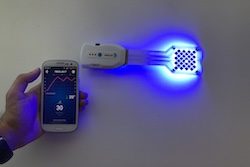- Home
- Editorial
- News
- Practice Guidelines
- Anesthesiology Guidelines
- Cancer Guidelines
- Cardiac Sciences Guidelines
- Critical Care Guidelines
- Dentistry Guidelines
- Dermatology Guidelines
- Diabetes and Endo Guidelines
- Diagnostics Guidelines
- ENT Guidelines
- Featured Practice Guidelines
- Gastroenterology Guidelines
- Geriatrics Guidelines
- Medicine Guidelines
- Nephrology Guidelines
- Neurosciences Guidelines
- Obs and Gynae Guidelines
- Ophthalmology Guidelines
- Orthopaedics Guidelines
- Paediatrics Guidelines
- Psychiatry Guidelines
- Pulmonology Guidelines
- Radiology Guidelines
- Surgery Guidelines
- Urology Guidelines
Smart dressing that uses healing power of blue light

Researchers have been able to produce a smart dressing that uses the healing power of blue light. The blue-light therapy in addition to wound healing can also monitor and treat infections,
Blue light is already known for its anti-bacterial and anti-inflammatory effects, but now the EU-funded MEDILIGHT consortium has harnessed it to aid the healing of chronic wounds such as those suffered by patients with diabetes.
“The aim is to have a non-chemical solution for chronic wounds,” says project coordinator Dionysios Manessis of the System Integration and Interconnection Technologies Department, Technical University Berlin. “We found that blue light originally thought to be good for disinfection also produces good results for proliferation of keratinocytes and fibroblasts — the types of skin cells needed for wound closure.”With EUR 3 million of EU funding for just over three years, the research team was able to produce a smart wearable device from scratch. The prototype consists of a soft, flexible foil with blue LEDs (light emitting diodes) and sensors. This is inserted into a transparent pocket over the wound dressing.
Attached to the foil is a small electronic box containing the circuit board with, among other components, the LED driver that regulates the intensity of blue light and a microcontroller or smart interface that acquires and analyses the sensor data so that adjustments to the light therapy regime can be made for each individual patient.
“The three — the flexible foil, the electronic box and the wound dressing — fit together as one holistic MEDILIGHT device,” Dr Manessis explains.
The foil’s sensors monitor temperature and blood oxygen levels at the wound site — oxygen levels indicate that the wound is healing while raised temperatures can be a sign of inflammation and infection. This data is communicated to the electronic box.
Testing of light therapy effects
In the first stages of healing, blue light irradiation inhibits the formation of bacterial colonies. Once the wound is disinfected, blue light intensity can be adjusted to prevent premature skin growth. “There has to be a good synchronisation of therapy schedules so that the wound does not close before it is disinfected and the risk of trapping bacteria inside the wound is completely eliminated,” says Dr Manessis.
In vitro studies on different bacterial strains revealed that blue light can prevent several strains common in infected wounds from reproducing and kills some types of bacteria.
"The effect of blue light on skin cell proliferation was tested in vitro, using different light intensities and wavelengths, and in vivo on mice, and has been patented," says Dr Manessis.
Innovative materials and software
The biggest technical challenge was minimising light loss so that sufficient blue light reaches the wound and ensuring heat generated by the LEDs is dissipated efficiently. “LEDs can generate heat and the temperature can rise up to 42–50 degrees, depending on the length of the light therapy,” Dr Manessis explains.
To address this, new wound dressing materials were developed by consortium partner URGO, France, and an advanced flex foil was designed and manufactured that enhances heat management. An innovative sensor acquisition interface and new software were developed under the project to transfer data wirelessly to a smartphone for evaluation and therapy adjustments.
A functional prototype flex foil that can be worn under the foot in a special shoe was also developed, connected wirelessly to the electronic box and controlled by a smartphone app that a health professional can use.
Human clinical trials on healthy and diabetic individuals will be conducted by URGO in the next stage of development towards product commercialisation.
blue lightdiabetesDr ManessisEU-fundedhealing powerMEDILIGHTphotonic band aidskin cellssmall electronic box
Next Story
NO DATA FOUND

Disclaimer: This site is primarily intended for healthcare professionals. Any content/information on this website does not replace the advice of medical and/or health professionals and should not be construed as medical/diagnostic advice/endorsement or prescription. Use of this site is subject to our terms of use, privacy policy, advertisement policy. © 2020 Minerva Medical Treatment Pvt Ltd